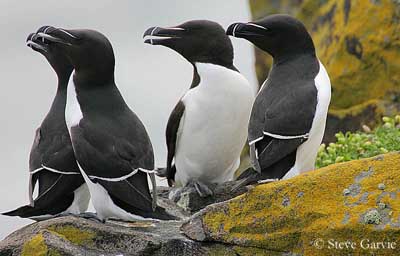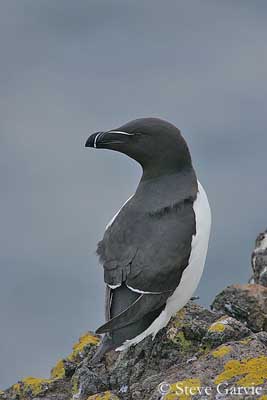
Fr: Petit Pingouin
All : Tordalk
Esp : Alca Común
Ital : Gazza marina
Nd: Alk
Sd: Tordmule
Photographers:
Steve Garvie
RAINBIRDER Photo galleries
René Lortie
http://rlortie.ca/
Text by Nicole Bouglouan
Sources:
HANDBOOK OF THE BIRDS OF THE WORLD Volume 3 by Josep del Hoyo-Andrew Elliott-Jordi Sargatal - Lynx Edicions - ISBN : 8487334202
THE HANDBOOK OF BIRD IDENTIFICATION FOR EUROPE AND THE WESTERN PALEARCTIC by Mark Beaman, Steve Madge - C.Helm - ISBN: 0713639601
THE COMPLETE BOOK OF BRITISH BIRDS – Written by “Royal Society for the Protection of Birds” experts - Préface de Magnus Magnusson - Michael Cady- Rob Hume Editors - ISBN: 0749509112
ENCYCLOPEDIE DES OISEAUX DE FRANCE ET D’EUROPE – de Peter Hayman et Rob Hume - Flammarion – ISBN : 2082009920
BirdLife International (BirdLife International)
Wikipedia, the free encyclopaedia
Razorbill
Alca torda
Charadriiforme Order – Alcidae Family
BIOMETRICS:
Length: 37-39 cm
Wingspan: 63-66 cm
Weight: 524-890 g
DESCRIPTION:
The Razorbill is a species of the rocky shores, cliffs and islands of the northernmost parts of the northern hemisphere.
Adult has blackish-brown upperparts. The upperwing is blackish-brown with white-tipped secondaries. Tail is blackish.
The underparts are white, with white underwing and blackish flight feathers.

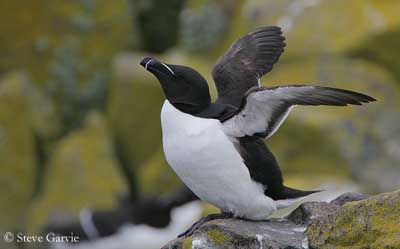
Head is black, as chin and throat. A conspicuous white line extends from the base of the culmen to the eye.
The large bill is black with transverse white line across both mandibles towards the tip. We also can see transverse ridges on the upper mandible.
The eyes are brown. The short legs and the webbed feet are blackish-grey.
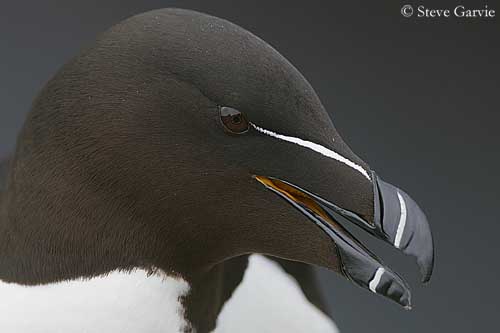
In winter plumage, throat, cheeks and ear-coverts are white, and the white line between the culmen and the eye is absent.
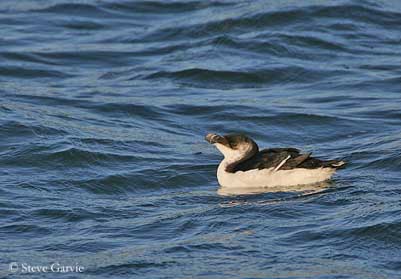
The female is slightly smaller than the male.
The juvenile is similar to adult in winter, but it has dark streaks on cheeks, ear-coverts, throat and breast sides. The white lines of the bill are less distinct.
We can find two subspecies, Alca torda torda from North America, and Alca torda islandicus from Eurasia. They differ in size and bill and wing length. The race Islandica is smaller.
VOICE: SOUNDS BY XENO-CANTO
The Razorbill is mainly vocal on the breeding areas, uttering typical call, a guttural, growled “goarr”. The young birds give plaintive piping at see.
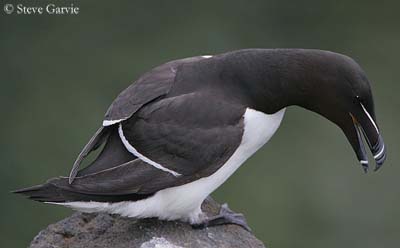
HABITAT:
The Razorbill breeds in rocky coastal regions on steep cliffs and on rocky offshore islands.
During winter, it occurs offshore, often at great distance, but usually at the continental shelf’s edges. It may extend southwards into warmer waters.
At sea, it forms flocks with other alcidae species of genus Uria.
RANGE:
The Razorbill breeds on the northern Atlantic coasts, from eastern N America to Western Europe, from NW Russia to N France.
The birds of North America migrate offshore and southwards, from Newfoundland to New England. The Eurasian birds also migrate offshore, and some populations move southwards to the W Mediterranean Sea.
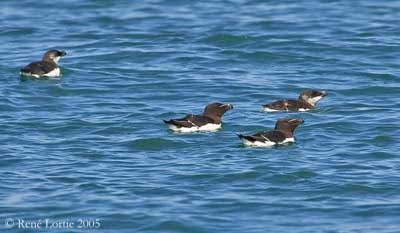
BEHAVIOUR:
The Razorbill feeds primarily on fish and crustaceans all year round, but the chicks are fed almost exclusively with fish.
They fish usually within 15 kilometres from the colony, and sometimes only at 2 kilometres. They bring the fish crosswise in the bill while flying to return to the nest.
The Razorbill dives during about one minute in shallow water, between 5 and 7 metres depth, but sometimes more, up to 10-15 metres depth. It propels itself underwater by beating the wings rapidly, as it does in flight. It dives from the surface, not from the air.
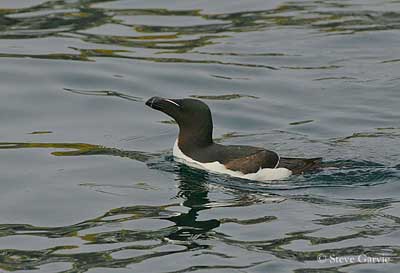
The Razorbill is loosely colonial and nests in small to large groups, often mixed with other seabirds’ species.
Before the copulation, both adults perform mutual preening on head and neck. Then, the copulation occurs on rocky ledge. This species is monogamous, with high fidelity to mate and breeding sites.
They migrate offshore at sea in winter, and southwards.
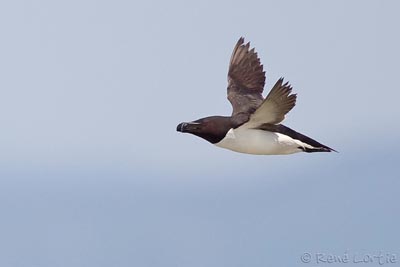
FLIGHT:
The Razorbill flies with active wing beats. The flight is direct and rapid, low over the water surface.
It also performs butterfly-like flight when taking off and circling, or landing on the sea.
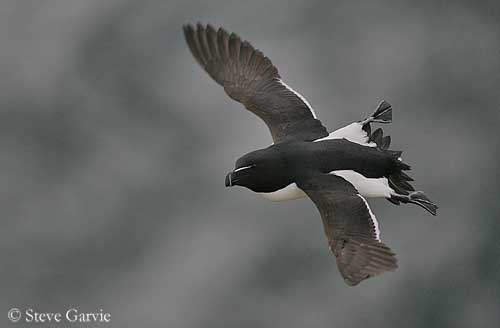
REPRODUCTION:
The breeding season varies according to the range.
The Razorbill breeds in loose colonies, often with other seabirds’ species. They often nest in rock crevices and caves, on cliff faces and exposed ledges.
The female lays only one egg directly on the rock, sometimes in a rough. Both sexes incubate during 35-37 days, taking turns of 12-24 hours.
The downy chick has mottled brown and buff upperparts. The underparts are white with mottled brown flanks.
It is semi-precocial and both parents feed and care it until it fledges. Then, the male accompanies the young to the sea. It becomes independent about three weeks later. It can breed at 4-5 years old.
It the egg is lost early in the season, the female may lay again two weeks later.
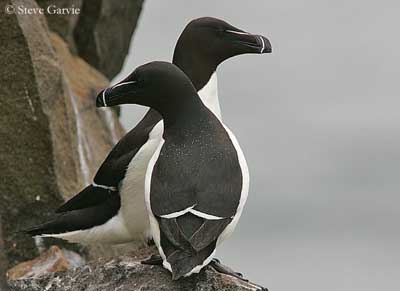
DIET:
The Razorbill feeds mainly on fish and crustaceans. The chicks are fed with fish. It dives underwater from the surface, and propels itself with the wings in order to pursue and catch the preys.
PROTECTION / THREATS / STATUTS:
The Razorbill has suffered large declines throughout N Atlantic since the 19th century, due to human disturbances and hunting.
This species is threatened by hunting pressure, overfishing of main preys’ species and oil pollution.
However, the species is not currently globally threatened, with declines alternating with increases of the populations, according to the regions.
